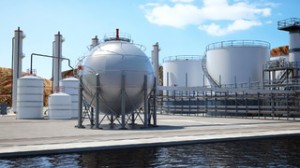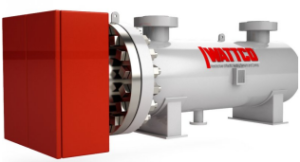Temperature control in cold winter climates with flanged or circulation heaters.
Last updated on September 26th, 2022 at 01:55 pm
With winter on the horizon, it is safe to say that everyone from man to machine is in need of adequate protection to brave the winter. The winter brings with itself cold and low temperatures that can hamper the production capabilities of industries that use aqueous or liquid based supplies, raw materials and products. This is not only true in case of the Oil and Gas industry which can be affected by cold and or freezing oil, this also applies to chemical industries and food packaging industry to name a few. 
Most of these liquids are often stored in large reservoirs of tanks for later use. Come winter time, as these tanks starts to brave the cold, these liquids can often start to freeze away and change their state and thus make material handling a challenge for transportation. If a liquid freezes, it can result in considerable material spoilage and revenue loss. The most efficient way to prevent liquid materials from spoiling is to utilize immersion heaters.
Protection from Cold
More often than not, the industries that need to have their machinery placed outdoors will face the major brunt of the cold temperature. Water based materials in cold conditions can start to freeze at 32 degree Fahrenheit and begin to show crystal formations. Chemicals and oil based liquids may start to solidify or transform into a gel-like substance as the temperature drops resulting in a decrease of viscosity levels.
There are a number of measures that can be implemented to keep these reservoirs and tanks from reaching 32 degree Fahrenheit. These include the use of step controllers and insulation to the tank in addition to using process heating.
Immersion Heaters
Immersion heaters are one of the most commonly used heater variants. Industrial immersion heaters have multiple industrial heating applications. Most immersion heaters heat through direct contact with the oils, solvents, gases, or viscous materials. Essentially, they function by producing and utilizing heat entirely within the liquids, making sure that little or no heat is lost during the process, guaranteeing 100% efficiency in heating applications.
The use of immersion heaters in cold climatic conditions is crucial because in most cases there is a requirement for the fluid to be kept at a different temperature than outside. Keeping the liquid at a higher temperature than the ambient temperature requires ample heating and energy capabilities that are best provided by immersion heaters.
If we take a look at the United States for example, every region experiences below-freezing cold at some time of the year. Some of the major industrial hubs are located in the Midwest and the Northeast which are prone to greater depths of low temperatures than any other part of the country. For petroleum, food, and chemical industries, maintenance of fluid temperature is critical for effective operations.
These industries require efficient and low cost heating solutions that can capitalize on the full potential of their heating capabilities. This is why immersion heaters such as flanged and circulation heaters are being used. Flanged heaters, for example, can be easily submerged directly into the liquid to heat and they are also easy to install which makes sure that they can be removed and reused in different tanks and for heating different liquids one after the other.
Similar to this are circulation heaters. These heaters make use of flanged heaters stationed inside the liquid and the rigid steel vessel. Circulation heaters heat liquids by letting the pumped liquid pass through the inlet of the heater; where the substance passes through the heating element. Once the material passes the heating element, it leaves the heater at the desired temperature.
One of the reasons why immersion heaters are in high demand is because of their versatility with a number of liquid applications. The design of the immersion heaters, be it flanged ones or circulation heaters, is such that their casing and heating elements are resistant to extreme wear and tear and contacts with highly corrosive chemicals. Most of these heaters come equipped with controllers thus making their use, installation, and maintenance convenient.
Flanged Heaters
These heaters are designed for use in pressurized vehicles and tanks; where they can heat both liquids and gases. A flanged immersion heater usually operates in combination with a flange. Flanged heaters used in winter time to prevent damage from cold temperatures and save liquid products from monetary and production-related damage.
A flanged heater is efficient in its working since all of the heat that it produces goes directly into the medium that was to be heated in the first place with little or no heat dissipated elsewhere.
Circulation Heaters
Also known as inline heaters, these heaters similar to flanged heaters and are used for heating gasses and liquids. The wide range of heating capabilities that circulation heaters can fulfill means that they can work well with both pressurized and non pressurized liquids to make sure they are kept away from the winter freeze. They are powerful heaters that are constructed using a flange mounted tubular heater or a screw plug. The inlet and outlet nozzles in the heater are what allow the heating to go on smoothly without the liquid spilling over.
Winter can be a hard time for liquids. While humans can use heaters to keep their homes warm, industries make use of immersion heaters such as flanged and circulation heaters to make sure that the temperature of the liquid is kept under wraps, preventing it from making crystals or being heated.

